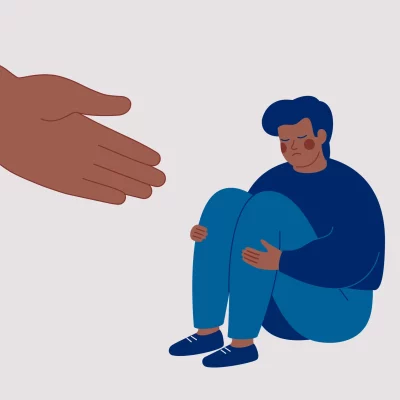Do you often feel like you need to keep your distance from people and avoid closeness or intimacy in relationships? If so, you may have an avoidant attachment style.
The avoidant attachment style is an insecure attachment characterized by a person’s reluctance to show their emotions or experience emotional closeness to others.
People with an avoidant attachment style often have difficulty forming and sustaining relationships, fearing getting too close and being rejected or hurt. They may also struggle with trust issues, feeling it’s better to stay distant than risk the pain of trusting someone.
Around 25% of the population has an avoidant attachment style, so if you can relate to these struggles you are not alone. Understanding the secure attachment style will be pivotal in moving toward optimal mental health. Read Part 1 of this series on Secure Attachment to create a clear picture of what healthy connection looks like, and how insecure attachments differ.
This post will discuss the origins of the avoidant attachment style, its signs and traits, how it can affect relationships, what can be done to move towards a more secure attachment style, and how to find support along the way.
How is an Avoidant Attachment Style created?
Avoidant attachment is one of the three main types of insecure attachment styles, forming when a child experiences inconsistent or unresponsive care from their caregivers. This lack of secure parenting can lead to mistrust and insecurity in adulthood, making it difficult for them to form and maintain relationships.
When a child does not receive consistent physical or emotional care from their primary caregiver, they may develop avoidant attachment as they learn that relying on others will only result in disappointment.
This type of parenting often leads children to suppress their emotions out of fear that expressing them will be met with rejection or indifference. By suppressing feelings, these children become emotionally distant from those around them. The lack of emotional connection and emotional bonds deeply affects the depth of adult relationships.
Absent parents are another factor contributing to the formation of an avoidant attachment style in children.
A parent who is absent either physically or emotionally due to work commitments, substance abuse issues, health problems, or other reasons beyond the child’s control, can contribute to feelings of insecurity and mistrust in adulthood.
In addition to inconsistent or absent parenting, trauma can play an essential role in forming an avoidant attachment style.
Traumatic experiences such as severe illness, the death of a loved one, and physical or emotional abuse can cause a child to form an insecure attachment as they learn that relying on others will not protect them from pain. As a result, they may become detached and closed off to prevent further hurt.
Signs of Avoidant Attachment
Avoidant adults can be characterized as people who avoid real connections with others. This can show itself through different types of behaviors.
Here are some signs and traits often exhibited by those with avoidant attachment:
- Fear of intimacy
- Inability to trust or open up to others
- Difficulty expressing emotions
- Avoidance of difficult conversations
- Preference for independence and autonomy
- Rejection of emotional displays from others
- Difficulty forming meaningful relationships with others
Each of these traits can show up differently in each person. Some examples of how these traits are seen are an unwillingness to commit to a relationship, difficulty making friends, and even avoiding physical contact.
People who struggle with avoidant attachment may also become overly self-reliant and independent, believing they do not need anyone else to be happy or to help even when they need it.
It is essential to know that, like with all attachment styles, how each person experiences their attachment style can differ. For example, you may need help with some traits but not others. Note these as you work to improve yourself and your personal relationships.
Fundamental Fears of Avoidant Attachment Style
If you suffer from avoidant attachment, you may experience fundamental fears related to your relationships with others. These fears often come in the form of trust and vulnerability, which can be difficult for someone who is insecurely attached. In this post, we will focus on the three main fears associated with this insecure attachment style.
1. The fear of being taken advantage of
Without a certain sense of trust, these individuals may think that coming into a relationship or friendship means handing over control to another person, thus making them vulnerable to manipulation or exploitation. This fear often manifests through a deep-seated need for control and feelings of distrust, leading them to build walls between themselves and others.
2. The fear of being emotionally overwhelmed by another person’s emotions
Feeling overwhelmed by someone else’s emotions can feel like suffocation or there is no space to process their own emotions. As a result, they may retreat as a coping mechanism for this fear.
3. The fear of rejection or abandonment due to their inability or unwillingness to express emotion or connection toward another person
As many with this attachment style have suppressed emotion to protect themselves from pain, they may feel like if they open up to someone emotionally, that person will reject or leave them in some way.
Furthermore, suppose a person opens up enough that it causes discomfort and their core fear to come to the surface. In that case, distancing themselves becomes a way of preventing potential abandonment from happening again in the future.
Overall, individuals with an avoidant attachment style have many irrational fears stemming from childhood experiences that prevent them from forming meaningful connections with others in adulthood. Understanding these fears can be vital in recognizing how one’s behavior can affect their ability to develop relationships moving forward.
How does having an Avoidant Attachment Style affect relationships
Each person, no matter the attachment style, shows their fears in different ways. Therefore, how those fears present in different types of relationships differs from person to person. Here are some ways that relationships can be affected with an avoidant adult.
Regarding friendships and romantic relationships, those with an avoidant attachment style may have difficulty forming meaningful connections with others that last over time.
The lack of genuine connection can lead to loneliness, isolation, and even depression.
In terms of friendships, this attachment style can prevent the development of deep and lasting connections with others.
Having strong connections to a community of people correlates to better immunity, quality of life, and increased lifespan. When avoidant adults keep everyone at arms length, they are limiting the intimacy they experience from their friendships, as well as potentially cause issues in other areas of life.
For example, someone with an avoidant attachment style might not feel comfortable sharing secrets or talking about their struggles with friends, leading them to feel isolated in social situations or feel “on the outside” from a group of people. Over time, that isolation can manifest in other ways, including depression and anxiety.
Those with an avoidant attachment style also have difficulty committing long-term to romantic relationships.
Due to their fear of abandonment, an avoidant person may become uncomfortable when things start getting too serious and distance themselves from the other person to protect themselves from potential rejection or hurt.
Their strong desire for independence can mean they have difficulty relying on someone else for support and comfort.
This may lead them to struggle when setting boundaries in romantic relationships and expressing feelings of love or admiration toward their partner.
For instance, someone with avoidant attachment might find it hard to commit emotionally or express deep emotions towards a partner due to fear of being vulnerable or opening up too much. They may view their emotions or needs as burdensome, and feel that no one would want to put the effort forward to meet their needs. By not being vulnerable and have their needs be heard, it reinforces the fears that are ruling their social interactions.
Overall, avoidant adults are more likely to struggle to form meaningful connections in friendships and romantic relationships due to their deep-seated fears related to trust and vulnerability. With the proper support and guidance, however, those individuals can learn how to create secure attachments while still being able to maintain a sense of autonomy and independence in life.
How to move toward a secure attachment style?
Fortunately, you can move from an avoidant attachment style toward a secure one.
The first step is recognizing your current patterns and acknowledging that change is possible.
Becoming aware of your behaviors and how they affect your relationships helps to begin the process of healing and establishing a secure connection with others.
The next step would be to determine how your attachment style was created based on your experiences in early childhood.
This knowledge is the foundation from which you can gradually heal the causes of your current behavior. Each part of how you behave in your adult relationships directly correlates to how you were nurtured during your childhood. Once you know what current behaviors are not serving you well and the roots from which those current behaviors stem, improving your attachment style is possible.
Finding a qualified therapist to walk through these steps with you is crucial to healing past trauma and creating a new, healthy narrative from which to live life.
Any therapy or healing takes time and lots of effort. It can be confusing how to begin the process or even how to make progress toward your goals. Having a mental health professional guide you through potentially tricky conversations and encourage you through doing things you typically avoid (like expressing your emotions) with a plan in mind helps make the process less intimidating.
As a person with an insecure attachment style, therapy can seem “too emotional” or vulnerable for your comfort level. However, it is crucial to understand that avoiding potential emotions will not help you overcome the limitations preventing you from having healthy attachment habits.
Going to great lengths to avoid pain or discomfort does not protect you from that pain; Instead, it perpetuates it.
The avoidance of situations, people, emotions, love, etc., all exacerbate the core fears of the insecurely attached person.
In relationships, running from someone who may abandon you or reject your emotions if you express them may seem like self-preservation. In reality, running from the emotions that scare you robs you of the fullness of the love that can surround you and that you deserve.
With growth toward a secure attachment style, expect increased self-esteem and self-confidence, as well as a stronger sense of emotional attachment to those around you. The core fears of your insecure attachment style won’t feel like such a burden to you, and you can trust others to be present and willingly meet your needs. Secure attachment may feel unattainable, but growing in this area is attainable.
Seeking Help
The ways in which avoidant attachment negatively affects your life can feel frustrating and daunting. If you want to move toward a secure attachment style, we can help! Whether you have an anxious, avoidant, or disorganized attachment style, there is hope to grow into a more securely attached adult.
Therapy can be an effective way for someone with avoidant attachment to learn how to form healthy attachments and emotional closeness to create more fulfilling relationships. When you schedule an appointment with a mental health professional, know that it is a safe space to explore feelings and experiences to gain insight into yourself. A customized plan can give you confidence that growth in the area of attachment and relationships is possible.
If you think you may be struggling with an avoidant attachment style, don’t hesitate to reach out for support – give us a call or start here to make an appointment with a licensed therapist.
For more information on attachment styles, here are more posts on this topic:
What is My Attachment Style? Part 1: Secure Attachment Style
What is My Attachment Style? Part 2: Anxious Attachment Style
What is My Attachment Style? Part 4: Disorganized Attachment Style








